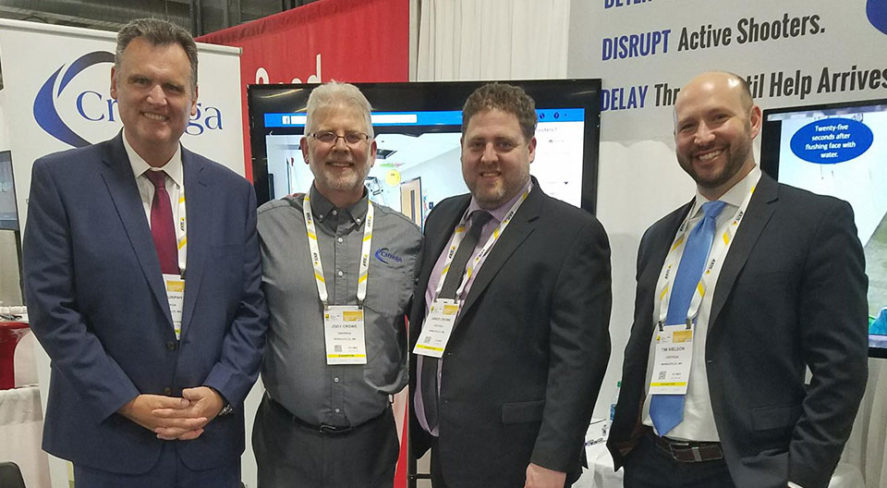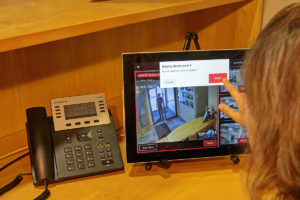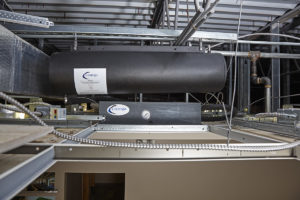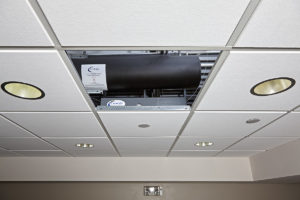New Member Profile: Crotega

New Security Industry Association (SIA) member Crotega – based in Minneapolis, Minnesota – was started after the Sandy Hook shooting by founder and CEO Jody Allen Crowe. As a former school administrator who had spent 25 years in school buildings, most of that time in high-risk schools, Crowe saw the need to protect school children and staff by suppressing active shooters in an effective, nonviolent manner. In the same way fire sprinklers suppress fires, he wanted to suppress active threats, and he brought together a team of mechanical, electrical and safety engineers, a chemist and an attorney to develop the first interior threat suppression system designed to deter, disrupt and delay active shooters.
Crotega’s remotely deployed threat suppression system works by drenching the perpetrator with a repulsive solution, impairing their ability to enact violence. The solution causes involuntary closure of the eyes, irritation to the nose, lungs, throat and skin and is deployed in short bursts. Crowe believes threat suppression is the next step in life safety and interior building security.
SIA spoke with Crowe – also an author and expert on school shooters – about Crotega, the security industry and working with SIA.
 SIA: What makes your offerings or your company unique?
SIA: What makes your offerings or your company unique?
Jody Allen Crowe: Crotega’s chemist and team of engineers have developed a smart threat suppression system – using the Repuls solution – that can be installed in zones in the mechanical spaces of ceilings. These zones can act like a “SWAT team in the ceiling” when a threat is detected in that zone. The Crotega Touch software provides remote deployment of the zones upon visual recognition of the threat. This patented, code-compliant system can be retrofitted in existing buildings and installed in new construction.
Crotega touch screens can be placed in strategic locations throughout a building. Alarm buttons and gunshot detection technology are used to alert the system. When a threat is seen, occupants of the building can hit a strategically located threat alert button that then brings the camera feed from the zone of threat to the touch screen. The trained individual can then deploy the threat suppression solution upon visual recognition of the threat in that zone and continue in adjacent zones as needed.
 SIA: What are the biggest challenges facing your company and/or others in the security industry?
SIA: What are the biggest challenges facing your company and/or others in the security industry?
JAC: Interior threat suppression is a change of paradigm in the security industry. The focus is and has been on keeping the threat out. People who work in schools know the school environment is not served well with increasing access controls and roving armed guards in schools, but there is a deep concern to find a solution for schools and, for that matter, any facility. Our challenge is to shift thinking away from relying on current approaches that have consistently failed to recognize that an armed threat must immediately be confronted with minimal risk to all.
We believe our solution does just that. There is a deadly gap in the minutes between when the shooting starts and when the police arrive and ultimately take control of the situation. Our goal is to fill that gap with an effective, low-risk solution. Far too often, an active shooter plan relies on solid principles but too much on hope and luck. This has resulted in numerous lives lost. Awaiting the police, running, hiding and fighting all mean critical minutes where control of the building is lost to the shooter. History has shown that there is a need to confront and suppress the shooter immediately, while still regarding the risk to all.
 SIA: What are your predictions for the security industry?
SIA: What are your predictions for the security industry?
JAC: We see an industry, and a world, seeking an answer to the growing problem of active shooters and other armed aggressors. Crotega foresees the universal recognition that most existing security measures are proven for day-to-day incidents but fail regularly against armed and determined persons. We see the mindset shift occurring already. We also see that reality for any organization is that an active shooter is a very low probability, so paying enormous ongoing expenses for an unlikely event almost always results in a withdrawal from that plan, leaving the organization as vulnerable as ever. Just as the risk of fire is low but severe, you wouldn’t pay a fire department to patrol your facility 24/7– instead, you build in permanent suppression capability. This problem requires the same approach: a cost-effective and impactful measure. Crotega sees the industry embracing interior threat suppression as the missing ingredient to a safe and secure building.
 SIA: What does SIA offer that is most important to you/your company? And what do you most hope to get out of your membership with SIA?
SIA: What does SIA offer that is most important to you/your company? And what do you most hope to get out of your membership with SIA?
JAC: Crotega leverages the SIA Updates for industry information. Recently, SIA has reached out to us to get information on our research into school shooters. Crotega leadership is excited about the possibilities of using SIA events, webinars and seminars to educate the security industry about interior threat suppression. Crotega is joining in the collective dialogue on moving the industry forward in a thoughtful and responsible manner.
SIA: How does your organization engage with SIA? What are your plans for involvement in the next year (e.g., events, accessing member resources)?
JAC: As an integral component of our marketing plan, Crotega has and will continue to participate in exhibiting and speaking at ISC West. We plan on participating in GovSummit, ISC East and webinars, where interaction and open discussion with industry experts will help us to ensure we are on track to deliver the right products to help save lives.
Learn more about Crotega here.
The views and opinions expressed in guest posts and/or profiles are those of the authors or sources and do not necessarily reflect the official policy or position of the Security Industry Association (SIA).
